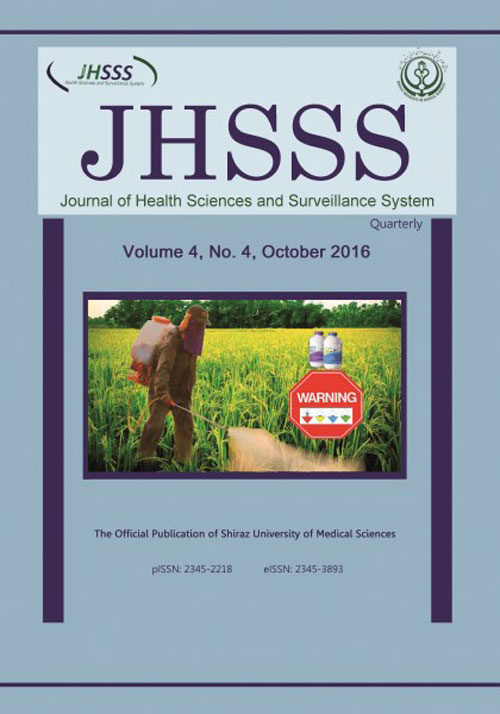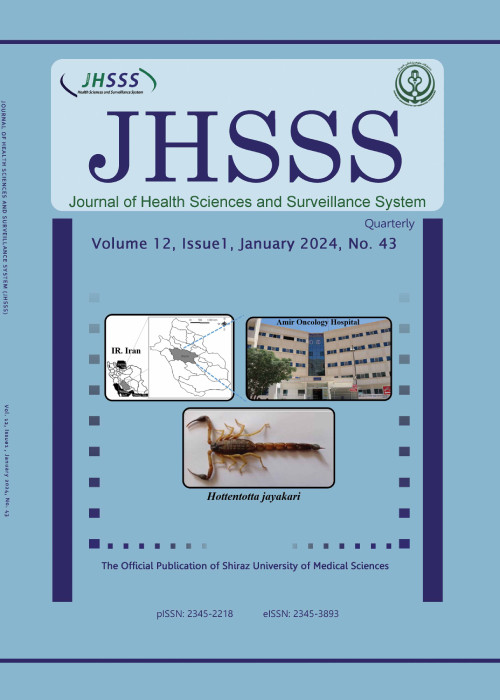فهرست مطالب

Journal of Health Sciences and Surveillance System
Volume:4 Issue: 4, Oct 2016
- تاریخ انتشار: 1395/10/12
- تعداد عناوین: 7
-
-
Pages 158-166BackgroundHazardous pesticides continue to be used in the farming industry purely because of economic reasons. Farmers need to understand this risk. Pesticide labels and pictograms were enforced to propagate this risk information to the farmers in a simple way. However, their effectiveness has not been evaluated in India. This study attempts to evaluate the efficacy of these labels and pictograms to help farmers understand the pesticide risks.MethodsA cross-sectional, questionnaire-based survey was conducted among 172 paddy farmers in Kancheepuram district of Tamil-Nadu, India. Their interpretation of four pesticide labels and fifteen pesticide safety pictograms were analyzed using (SPSS version 20) for descriptive statistics. Chi-square test was used for dichotomic variables. A p value ofResultsOf the 172 farmers interviewed, 93% were unaware of the pesticide regulations and 72.6% had never attempted to read the labels. Only, the red color in the label was identified correctly by 66.1% of farmers. Four out of fifteen pictograms were interpreted correctly by more than 60% of the farmers. Educational status had a significant influence on the way the labels and pictograms were interpreted.ConclusionWe need to consider restructuring these labels in a more scientific way. Instead of a top-down approach, we need to start working at the grass root level if we tend to have better appreciated labels. It is recommended that plans and strategies should be devised to educate the farmers about the labels and pictograms.Keywords: Pictograms, Pesticide Labels, farmer's interpretation, educational status
-
Pages 167-173BackgroundPrenatal care consists of a series of clinical visits and services offered to pregnant women throughout the antepartum period. Despite advances in the extent of prenatal care use in Iran, some women still avoid using these services. It is, therefore, very important to investigate the prevalence of prenatal care use, and to identify the factors associated with it. This study analyzes prenatal care use in Fars Province between 2000 and 2010, identifying the associations between womens demographic and socio-economic characteristics and prenatal care use.MethodsThe study is quantitative and based on secondary data drawn from IDHS 2000 and MIDHS 2010. The sample consisted of 765 individuals from Fars Province. The data were weighted to reflect the characteristics of the rural-urban population. Statistical analyses were carried out using SPSS-18. In the inferential analysis, bivariate and multivariate logistic regressions were applied.ResultsIt was indicated that both the quantity and quality of prenatal care increased during 20002010. Obstetricians and gynecologists became the primary reference point for women accessing healthcare during this period. Our study indicates that, in the final analytical model, the educational attainment (OR=1.32, P=0.035), urban place of residence (OR=10.49, P=0.003), sanitary and health status of households (OR=5.04, PConclusionWomen who do not have access to prenatal care are mainly from families with low socio-economic status. Thus socially vulnerable groups receive deficient prenatal care, indicating the need for government investment and planning in a comprehensive insurance system.Keywords: Prenatal care, Reproductive health, Health services
-
Pages 174-180BackgroundGifted individuals have exclusive personality traits and need various experiences to achieve more information about themselves and their ability into developmental process from giftedness to talent. Also, they can increase mental experiences and obtain greater self- actualization with recognition of the level of challenges, values and their personality traits. The aim of this study was to assess the relationship between personality traits, self-awareness and self-actualization dimensions.MethodsThis descriptive study was conducted in Shiraz city among 239 gifted students from high schools during 2013. The Big Five Personality Questionnaire (BFPQ), Self-Consciousness Scale (SCS) and Measure of Actualization of Potential (MAP) were used to gather the data. Validity and reliability of these tools were acceptable. Data were analyzed by regression test using SPSS v19 statistic software.ResultsThe finding showed that agreeableness (r=0.34) and conscientiousness (r=0.41) factors (from five factors of personality) had a positive relationship and neuroticism (r=-0.21) had a correlation with self-actualization negatively. Moreover, the privative self-awareness (r=0.41) and public self-awareness (r=0.15) showed a positive correlation and social anxiety revealed a significant negative relationship (r=-0.27) with general selfactualization. On the other hand, privative self-awareness and agreeableness predicted that 23% of the scores belong to openness to experience dimension (selfactualization) positively. In addition, conscientiousness and privative self-awareness predicted self-reference dimension positively, and neuroticism predicted it negatively. These variables determine 40% of the scores of self reference dimension. Also, conscientiousness, agreeableness and privative self-awareness predicted that 36% of the scores belong to general self-actualization.ConclusionBased on our study results, conscientiousness and agreeableness factors (personality traits) had a significant relationship with self-actualization and predicted the scores of self-actualization. It was noted that privative self-awareness (selfawareness dimension) had a significantly positive correlation with self-actualization and predicted its scores.Keywords: Gifted students, Iran, Personality traits, Self-actualization, Self-awareness
-
Pages 181-188BackgroundVitamin D deficiency is implicated in a wide range of pathological situations including cardiovascular diseases. This study aimed to investigate the association between serum 25-hydroxy vitamin D (25(OH)D) and risk factors of metabolic syndrome and cardiovascular diseases.MethodsThe cross-sectional study was conducted on 169 adults (88 males, 81 females) aged 19-52 years living in Shiraz, Iran. Anthropometric characteristics and blood pressure were measured using standard methods. Blood samples were collected in fasting state for determination of blood glucose, lipids, and 25(OH)D. Data were analyzed with one-way analysis of variance and linear regression using SPSS software.ResultsSerum 25(OH)D concentrations were considerably higher in males. One third of females had vitamin D deficiency (25(OH)D 50 ng/ml. In males, systolic and diastolic blood pressure, triglycerides, and metabolic syndrome score increased and high-density lipoprotein (HDL) cholesterol decreased across tertiles of serum 25(OH)D. On the contrary, in females body mass index (BMI) and metabolic syndrome score decreased and HDL cholesterol increased across tertiles of 25(OH)D. Linear regression, after controlling for confounding factors, showed that diastolic blood pressure (B=0.07; 95% CI: 0.02, 0.11; P=0.006), triglycerides (B=0.54; 95% CI: 0.22, 0.85; P=0.001), and metabolic syndrome score (B=0.01; 95% CI: 0.001, 0.01; P=0.02) positively and HDL cholesterol (B=-0.05; 95% CI: -0.09, -0.01; P=0.02) inversely associated with tertiles of 25(OH) D concentrations in males. In contrast, BMI (B=-0.06; 95% CI: -0.11, -0.02; P=0.01), waist circumference (B= -0.12; 95% CI:- 0.23, -0.01; p=0.04), and metabolic syndrome score (B=-0.02; 95% CI:-0.03, -0.01; P=0.01) were inversely and HDL-C (B=0.16; 95% CI: 0.02, 0.31; P=0.02) positively associated with 25(OH) D tertiles in females.ConclusionThe results suggest that both low and upper normal levels of 25(OH)D are associated with increased risk of cardiovascular diseases and metabolic syndrome.Keywords: Vitamin D, Metabolic syndrome, Cardiovascular diseases
-
Pages 189-193BackgroundStudies have shown that some personal characteristics such as perfectionism are associated with cardiovascular diseases. Hence, this study was designed with the aim of doing a comparative evaluation of perfectionism in coronary heart disease patients and healthy individuals referred to Shahid Faghihi Hospital in Shiraz.MethodsThis is a case-control study carried out on 80 cardiovascular patients and 80 healthy people who referred to Shahid Faghihi Hospital. The sampling was done through the convenience sampling method. The Frost Multidimensional Perfectionism Scale (FMPS) was used to collect the information. Besides, t-test was applied to analyze the data in the SPSS software, version 16.ResultsThe mean ages of the participants in this study were 48±12.2 and 34±9.6 in patients and normal subjects, respectively. Negative perfectionism among the people with cardiovascular disease was higher than the healthy individuals (69.5±12.8 and 64±15.5, respectively, with P=0.03) and there was a significant difference between these two groups. In terms of perfectionism subscales, there was a significant difference between the two groups regarding personal standards (PConclusionIn general, our study results showed that there was no significant difference between patients with cardiovascular disease and normal subjects in terms of perfectionism, but a significant difference was seen between some subscales of perfectionism in the two groups.Keywords: Perfectionism, patients with cardiovascular disease, healthy people
-
Pages 194-198BackgroundEscherichia coli, known as a clinically significant bacteria, can cause a wide range of infections, including urinary tract infections (UTIs), blood stream infections (BSIs), and can frequently be isolated from various clinical specimens. Evaluation of antimicrobial resistant pattern is a necessary action, especially about such bacteria which are frequent and life threatening. The aim of this study was to determine the frequency and antimicrobial resistance pattern of E. coli isolates obtained from various clinical specimens.MethodsThis retrospective study was performed within a seven month period from January 2015 to August 2015 at a specialized women and children hospital in Shiraz, Iran. E. coli isolates were obtained from various clinical specimens and identified using standard microbiological procedure. Antimicrobial susceptibility patterns were determined using disk diffusion method in accordance with CLSI recommendation.ResultsOf the total 130 positive cultures, the majority of E. coli isolates were obtained from urine (96=73.8%) and blood (11=8.5%) specimens. Overall, gentamicin (70.8%) was the effective antibiotic for the tested E. coli isolates. E. coli isolates obtained from urine specimens showed the highest resistance rates against ampicillin (84.4%) and nalidixic acid (61.5%); while they showed the most sensitivity to gentamicin (79.2%), nitrofurantoin (70.8%) and ciprofloxacin (66.7%). Moreover, the highest antibiotic resistance rates belonged to the isolates recovered from endotracheal tube (ETT).ConclusionThe results showed that gentamicin was the most effective antibiotic against E. coli infections. However, in addition to the gentamicin, we can recommend nitrofurantoin and ciprofloxacin as the other effective agents for UTIs.Keywords: Escherichia coli, Women, Children, Nosocomial infections, Antibiotic susceptibility
-
Pages 199-204BackgroundSleep disorders like snoring, mouth breathing, and insomnia are frequent in pregnancy and studies have shown that poor sleep is linked to obstetric complications. Muscle relaxation technique is an effective method used for improving sleep quality. The purpose of this study was to determine the effect of muscle relaxation technique on fetal outcomes in complicated pregnancies with sleep disorders.MethodsThis study was performed as a clinical trial on 160 pregnant women who suffered from preeclampsia and gestational diabetes. The participants filled the Pittsburgh Sleep Quality Index (PSQI) in order to measure the quality and patterns of their sleep. The participants with the total score of 5 or more were included in the present study. Intervention group were asked to use muscle relaxation technique twice a week at home for 8 weeks alongside the routine care. Study variables included sleep quality, Apgar scores, birth weight, levels of Interleukin- 6 (IL- 6), as well as umbilical cord PH and PO2.ResultsThe mean score of PSQI before the intervention was 9.28±4.16 and 9.18±3.06 in the intervention and control groups without a significant difference (P=0.6), respectively. However, PSQI global score of the experimental group was smaller than the control group at the end of the study (PConclusionThe results of this study showed that muscle relaxation, as a simple, inexpensive and safe method, can improve the fetal outcomes such as birth weight, Apgar score, cord blood po2, and cord blood PH, and also it leads to lower IL-6 in complicated pregnancies.Keywords: Muscle relaxation, High risk pregnancy, Fetal outcomes, Sleep disorders, Preeclampsia, Gestational Diabetes


